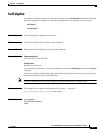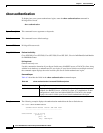
5-11
Cisco SFS 7000 Series Product Family Command Reference Guide
OL-9163-02
Chapter 5 IP Commands
redundancy-group
redundancy-group
To create or configure a redundancy group, enter the
redundancy-group
command in Global
Configuration mode. To disable an attribute of a redundancy group or to delete a redundancy group, use
the
no
form of this command.
redundancy-group
rg-number [
broadcast-forwarding
|
load-balancing
|
multicast
|
new-member-force-reelection
|
name
name]
no redundancy-group
rg-number [
broadcast-forwarding
|
load-balancing
|
multicast
|
new-member-force-reelection
]
Syntax Description
Defaults By default, load balancing does not run on redundancy groups.
Command Modes Global Configuration (config) mode.
Usage Guidelines
Platform Availability:
Cisco SFS 3001, Cisco SFS 3012
Privilege Level:
Ethernet read-write user.
Create and configure redundancy groups with this command.
Examples The following example creates a redundancy group:
SFS-7000P(config)# redundancy-group 11
Related Commands show redundancy-group
bridge-group
rg-number Number of the redundancy group.
broadcast-forwarding (Optional) Enables broadcast forwarding for all members of the redundancy
group
load-balancing (Optional) Enables load balancing among all members of the group.
multicast (Optional) Enables multicast forwarding for all members of the redundancy
group
new-member-force-ree
lection
(Optional) Configures the redundancy group to force reelection when a new
member joins.
name (Optional) Configures a name for the redundancy group
name Name to assign to the redundancy group.


















